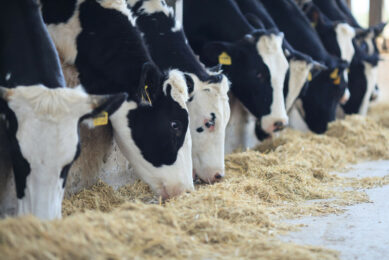Antibiotics in DDGS may raise some concerns
Of the distillers grains produced in North America, 90% is going into animal feeds with 80% of that going into ruminant diets. Now, public concern has arisen over the safety of the product.
The reason for this concern is a recent survey of the US Food and Drug Administration (FDA) which found that 53% of the US distillers grains (DDGS) sampled had antibiotic residues.
General fear is that these residues could potentially lead to the development of bacterial resistance in animals and eventually also in humans.
Wet or dry milling
DDGs are primarily produced through dry or wet milling. In dry milling, the whole grain is milled and used for ethanol production.
Wet milling, on the other hand, separates out all of the grain components and only uses the starch for ethanol production. The remaining portion of the grain is used to create a variety of other marketable products.
With each method, the grain or the starch is added to water to create a mash. The mash is heated and enzymes are added to the mixture which allows the starch to breakdown and form glucose.
Protecting the yeast
Next, the mash is fermented. During fermentation, yeast is added to the mixture. The yeast converts the glucose to alcohol. However, during this step bacteria can compete with the yeast, utilizing the glucose to grow. This in turn reduces the amount of ethanol produced from the fermentation process.
In order to combat these competing bacteria, antibiotics are added to the fermentation process. Antibiotics can kill the unwanted bacteria during the fermentation process allowing the yeast to utilize all of the glucose.
Separation of solids
Once fermentation is complete and all of the glucose has been converted to alcohol, the alcohol is separated from the water and solids through a distillation column.
After distillation all that remains are the solid (wet cake) and liquid (thin silage) components of silage. The silage is made up of protein, fibre, oil, and non-fermented starch at a concentration three-fold greater than that in the original corn.
Additionally, antibiotic residues from the fermentation will be present.
Dosing problem
Antibiotics have been used in fuel ethanol production for decades in order to improve production efficiency by reducing levels of contaminating bacteria present during the fermentation of ethanol, allowing for a more productive fermentation.
Antibiotic resistance develops in bacteria during ethanol production due to the misuse of antibiotics. This includes antibiotic overdosing when no effect is observed and underdosing when efficient control is observed.
Overdosing affects the rate of fermentation. Underdosing, on the other hand, leads to a lack of effectiveness of antibiotics. It also carries a greater risk of causing resistance, as bacteria can become accustomed to the antibiotic in low doses and thus develop resistance mechanisms.
FDA responsibility
It is the responsibility of the FDA Centre for Veterinary Medicine (FDA/CVM) to approve the use of drugs in animal feeds, as well as monitor and establish limits for feed contaminants.
Antibiotic residues in distillers grains used as feed or feed ingredients are considered feed additives and regulated by the FDA.
FDA’s primary concern is that antibiotic residues may be present in distillers grains and that those residues could be transferred to animal tissue upon ingestion.
Viginiamycin
The only antibiotic currently approved for use in ethanol production is virginiamycin.
The FDA/CVM issued a letter of no objection for the use of virginiamycin in the fermentation phase of alcohol production at 2 to 6 ppm.
In addition, the CVM did not object to potential residues of 0.2 to 0.5 ppm in distillers by-products. This statement was based on an animal diet containing no more than 20% DDGS.
Moreover, it was stated that the FDA/CVM is unlikely to take regulatory action against DDG-containing feed with residual levels of virginiamycin below 0.5 ppm.
Activity not tested
Although antibiotic residues have been confirmed in distillers grains by the FDA, the activity level of those residues has never been tested.
It is possible that the residues present have been inactivated by the ethanol production process, as the antibiotics are exposed to high and low temperatures and a wide pH range.
Further studies will help to confirm the potential implications of feeding distillers grains with antibiotic residues.
Related article: Multiresidue detecting antibiotics in DDGS
Distillers grains glossary
In order to separate the liquid portion of the silage from the solid portion, centrifugation is used. The wet portion, or thin silage, is evaporated further to produce a thick syrup called condensed solubles. The condensed solubles can then be added to the wet cake to produce a variety of products.
- DWGS – condensed solubles mixed back with partially dried wet cake to create 65% moisture distillers wet grains with soluble;
- DDS – dried condensed solubles or distillers dried soluble;
- DWG – dried wet cake without condensed soluble known as distillers wet grains;
- DDG – further dried DWG to produce dried distillers grains;
- DDGS – dried DWG with solubles to 10 to 12% moisture creating distillers dried grains with soluble;
- MDGS – 50% moisture wet cake with condensed soluble creating modified distillers grains with solubles.











